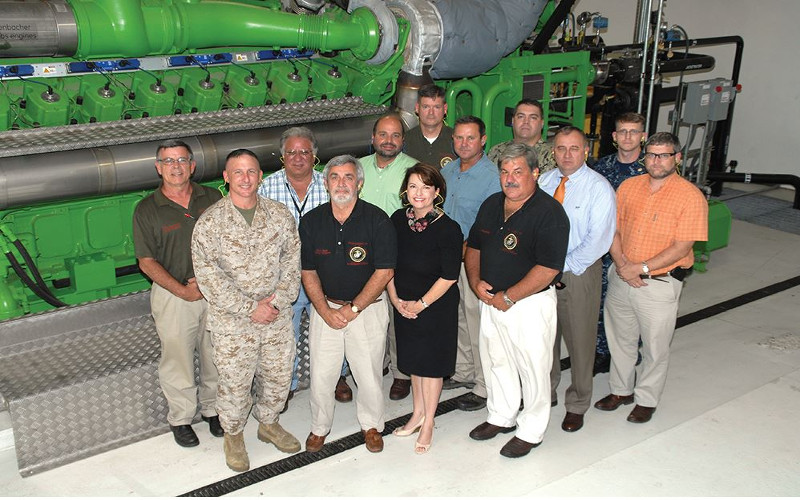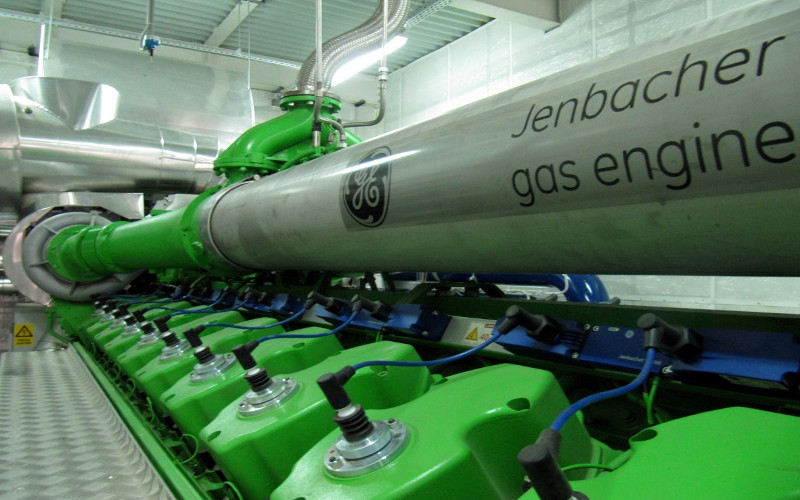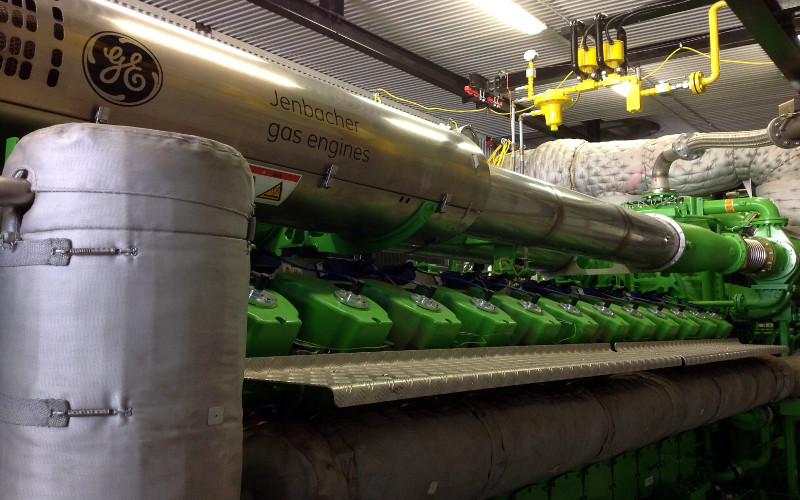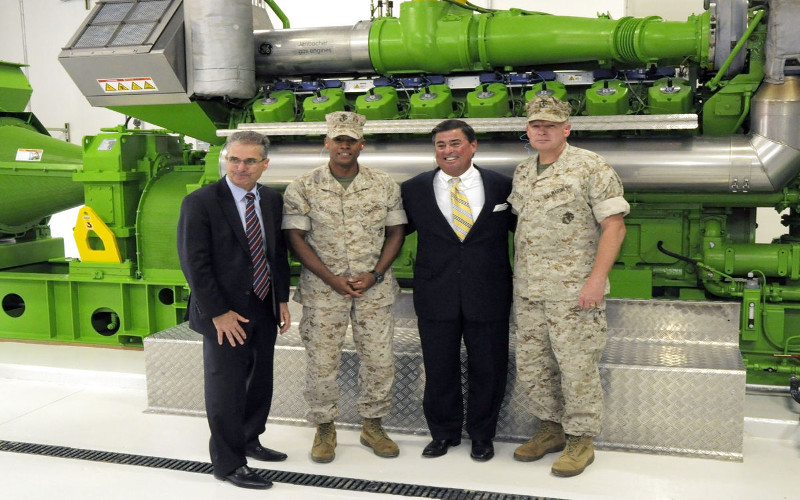Project Description
Project Name
Methane-Derived CHP Microgrid
Location
MCLB Albany, Georgia
Challenge
Reliable Renewable Energy with Energy Savings
Description:
Marine Corp Logistic Base (MCLB) Albany is home to Navy’s first renewable biogas landfill gas-to-energy (LFGE) resulting from a public-private cooperative effort with MCLB and Dougherty County, Georgia. Interest in islanding capabilities for both thermal and electrical energy during outage events led to incorporating microgrid elements into the 6-MW (TOTAL) combined heat and power (CHP: 4 MW thermal + 2 MW electrical) LFGE plant with LFG as the primary fuel source backed up by natural gas.
LFG is provided from Dougherty County’s landfill located adjacent to the Base with the compression-and-dehydration station located on County property at the landfill. The pipeline will transport LFG from the station to the new LFGE plant located on MCLB property approximately four miles away. The plant will contain a dual-fuel engine generator, a stack heat recovery steam generator, two dual-fuel boilers, and the switchgear necessary to convert the LFG into energy for the Base’s Maintenance Center (MCA), which is MCLB’s largest energy consumer.
The Marine Corp Logistics Base, (MCLB) Albany is home to the U.S. Department of Navy’s first renewable methane-derived landfill gas-to-energy (LFGE) combined heat and power (CHP) microgrid project that resulted from a Public-Public-Private Partnership (P4) involving three government agencies and one private sector company. The project was developed under the U.S. Department of Energy’s (DOE) Energy Savings Performance Contracting (ESPC) program with two federal agencies, DOE and the U.S. Department of Defense, one local government agency, Dougherty County, Georgia, and Chevron USA Inc.
In order to provide renewable fuel to the new onsite CHP microgrid that would serve mission critical loads, Dougherty County entered into a methane off-take agreement with MCLB. Instead of flaring excess landfill-derived methane as they’d previously been doing, Dougherty County elected to reduce their greenhouse gas emissions by capturing and diverting the methane for a beneficial purpose that also served to create a new revenue stream for the County.
Two of PowerSurety’s principals were responsible for managing and overseeing development of the CHP microgrid project over a multi-year period while under the employ of Chevron USA Inc. Due to the project’s technology approach, commercial structure, operational impacts, and risk profile, PowerSurety principals guided the project team through the project’s planning, development, engineering, economic and cost/pricing analysis, structured financing, and contract negotiation/award processes.

Interest in islanding capabilities for both thermal and electrical energy during outage events led to configuring the 6 MW total CHP (4 MW thermal and 2 MW electrical output capacity) into a microgrid. The CHP microgrid utilizes LFG as its primary fuel source and is backed-up by natural gas.
LFG is provided from Dougherty County’s landfill located adjacent to the Base with a compression and dehydration station located on County property at the landfill. The subsurface LFG pipeline that Chevron funded and built, transports methane from the compression station to the new CHP microgrid plant located on MCLB property approximately four miles away. The facility contains a dual-fuel Jenbacher reciprocating engine generator, a stack heat recovery steam generator, two dual-fuel boilers, and the switchgear necessary to convert the LFG into energy for the Base’s Maintenance Center Albany (MCA) industrial depot-level maintenance facility, which is MCLB’s largest energy consumer.
CHP Microgrid Project Awards
2010 Secretary of the Navy Energy and Water Management Gold Award
2011 Secretary of the Navy Energy and Water Management Gold Award
2012 Secretary of the Navy Energy and Water
2012 Association of Energy Engineers Region II Energy Award
Thermal energy is supplied from the CHP microgrid as steam to an MCLB central plant to offset the standalone natural gas-derived generation of steam for distribution throughout the installation. Biogas is used in a combination of boilers and a heat recovery steam generator (HRSG) to afford MCLB maximum flexibility for fuel switching. This Multi-Fuel / Multi-Unit / Multi-System strategy maintains availabilities of thermal energy supplied to critical loads at high levels. Thermal generators consist of two 12.5 MMBtu boilers and one 5.5 MMBtu HRSG in addition to the existing boiler plant, which remains intact for purposes of system redundancy. Biogas boilers have fuel mixing capabilities to accommodate steam production with varying ratios of biogas and natural gas.
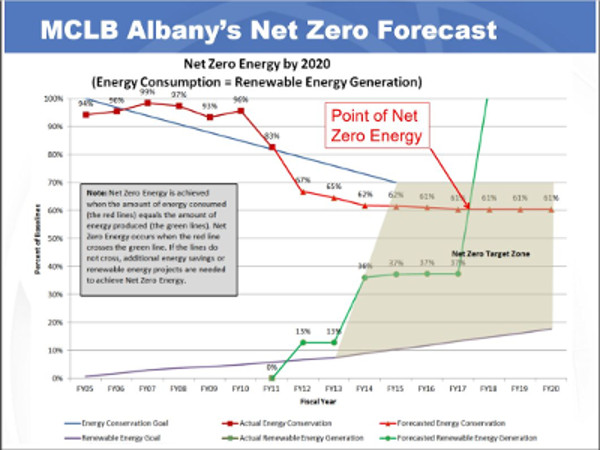
The project also provides ancillary energy surety benefits since it displaces 19 percent of the Base’s purchased natural gas and electricity, and also reduces the Base’s energy intensity by 16 percent. This reduction in baseline energy use, combined with microgrid-enabled distributed generation, provides for increased energy security and reliability. The CHP microgrid can operate in parallel with the utility grid or in island mode, and can run either using straight LFG or with an LFG-natural gas blend. In the event of an electrical grid outage, the generator can operate on 100 percent natural gas, providing onsite power to support critical requirements and loads.
The benefits of the project are numerous: MCLB has improved its level of energy resilience, funded the microgrid project with the cost savings it self-generated, and reduced its greenhouse gas footprint by reducing its volume of purchased electricity and natural gas. Dougherty County created a new revenue stream and assisted one of its key constituents in implementing a mission critical project; and the world benefitted from a significant greenhouse gas reduction project. This P4 project surely created mutual benefit for each partner and for the broader community alike.


